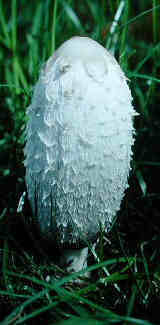| 10-13-08
As the sun heads south, the questions on fall
mushrooms tend to mount -- chiefly about the shaggy mane (a k a Coprinus
comatus), which I consider the most easily found and tastiest of all
wild mushrooms.
The shaggy mane, thusly dubbed because of the
tan scaly “shingles” on the white cap, may be found almost anywhere, but
my favorite haunts for this mushroom are grassy plots. I used to further
that by thinking spots that were four or five years old were best, but
now I search all grassy plots.
This, of course, means that I spy more shags from
my car seat than walking. I just drive (I cover more ground than on foot)
and keep a watchful eye (when traffic is light) on the lawns. That explains
my pseudonym, “Shaggy Mane Pirate.” I simply drive fast enough to avoid
being a traffic hazard (often with hazard lights winking) and search likely
spots, at slack traffic times.
|
 |
The angel-white caps and stems of shags seem to telegraph
their presence.
The cap of the shag is more or less like an elongated
egg, attached to the hollow stem at both ends. When they are attached to
the stem at both ends is an ideal time to harvest them. When the cap breaks
away from the stem it is okay, but soon thereafter the cap (still attached
to the stem at the center of the parasol top) it will start turning an
inky black, and will no longer be edible. This inky black, jelly-like substance
that infiltrates the cap, starts at the outer perimeter of the cap at the
point where it is attached at the bottom of the cap and proceeds upward.
No matter how high the black goes, if it is cut away, the remaining white
tissue still is edible. Stems, of course, are very tough and discarded.
For that reason, when making a shag edible (no
matter how small), I place it lengthwise on a cutting board and trim the
shag crosswise to remove the stem at the top and bottom. With the stem
severed at both ends, I push the middle part of the stem out of the cap
section which is ready to be dipped into egg-milk (50-50) and then dredged
in a mix of finely rolled cracker meal (I use Club crackers, rolled fine
and mixed 50-50 with flour and cornmeal) and fried to a golden brown on
both sides. While they are frying (in olive oil or butter), I flatten each
mushroom slightly to make sure it is exposed to the cooking agent. This
is a must procedure.
To roll the crackers fine, I place a dozen or
so in a plastic bag that can be closed at the top. Then grind them up with
a rolling pin. Mix the cracker meal with flour, cornmeal, or both. You
may want to dust the mix with garlic powder. Mix one or two eggs with an
equal amount of milk (or less) for first dipping the mushrooms, then dredging
them with cracker meal mix.
It is good to fry shags soon after they are cleaned
(at least same day). Over the years, however, I have learned that exposure
to air brings about the transition to the black jelly substance. By cutting
away the outer perimeter of the cap, I eliminate the place where the black
transition starts. By keeping them immersed in water and refrigerated,
I eliminate exposure to air. I have kept shags fresh and edible in this
manner for a week or more. But the longer shags are immersed in water,
the more they become saturated and soft.
Click on thumbnail image for enlarged view.
 |
The
shag cap is trimmed at both ends to thwart development of the black inky
glob, and to eliminate the tough stem. Spot where stem hooks into the top
of the cap is tough too. |
|

